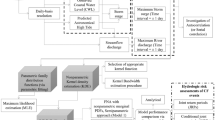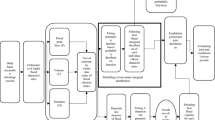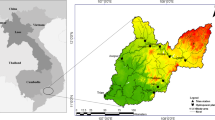Abstract
The joint probability modelling of storm surges and rainfall events is the main task in assessing compound flood risk in low-lying coastal areas. These extreme or non-extreme events may not be dangerous if considered individually but can intensify flooding impact if they occur simultaneously or successively. Recently, the copula approach has been widely accepted in compound flooding but is often limited to parametric or semiparametric distribution settings in a limited number of cases. However, both parametric and semiparametric approaches assume the prior distribution type for univariate marginals and copula joint density. In that case, there is a high risk of misspecification if the underlying assumption is violated. In addition, both approaches suffer from a lack of flexibility. This study uses bivariate copula density in the nonparametric distribution setting. The joint copula structure is approximated nonparametrically by employing the Bernstein copula estimator and Beta kernel copula density, and their performances are also compared. The proposed model is tested with 46 years of rainfall and storm surge observations collected on Canada's west coast. The marginal distribution of the selected flood variables is modelled using nonparametric kernel density estimation (KDE). Based on the different model compatibility tests, the Bernstein copula with normal KDE margins defined the joint dependence structure well. The selected nonparametric copula model is further employed to estimate joint and conditional return periods. It is found that flood hazard characteristics occurrence simultaneously is less frequent in AND-joint cases than in OR-joint cases. Also, the derived model is further used to estimate failure probability (FP) statistics to assess the variation of bivariate hydrologic risk during the project lifetime. It is found that FP statistics could be underestimated when neglecting the compound effect of storm surge and rainfall in the coastal flood risk.











Similar content being viewed by others
Data Availability Statement
Data used in the presented research are available at https://tides.gc.ca/eng/data (CWL data); https://wateroffice.ec.gc.ca/search/historical_e.html (Daily streamflow discharge records); https://climate.weather.gc.ca/ (Daily rainfall data).
Abbreviations
- KDE:
-
Kernel Density Estimation
- FP:
-
Failure Probability
- CF:
-
Compound Flooding
- JRP(s):
-
Joint Return Period(s)
- PDF(s):
-
Probability Density Function(s)
- CDF(s):
-
Cumulative Distribution Function(s)
- EV:
-
Extreme value
- GEV:
-
Generalized Extreme Value
- SLR:
-
Sea Level Rise
- MSE:
-
Mean Square Error
- RMSE:
-
Root Mean Square Error
- MAE:
-
Maximum Absolute Error
- AIC:
-
Akaike Information Criterion
- BIC:
-
Bayesian Information Criterion
- HQC:
-
Hannan-Quinn Information Criterion
- NSE:
-
Nash-Sutcliffe Model Efficiency
- CWL:
-
Coastal Water Level
- MLE:
-
Maximum Likelihood Estimation
- DPI:
-
Direct Plug-in
- AMISE:
-
Asymptotic Mean Integrated Squared Error
- MK:
-
Mann-Kendall
- CHS:
-
Canadian Hydrographic Service
References
Adamowski K (1989) A Monte Carlo comparison of parametric and nonparametric estimations of flood frequencies. J Hydrol 108:295–308
Akaike H (1974) A new look at the statistical model identification. IEEE Trans Autom Control 19(6):716–723
Archetti R, Bolognesi A, Casadio A, Maglionico M (2011) Development of flood probability charts for urban drainage network in coastal areas through a simplified joint assessment approach. Hydrol Earth Syst Sci 15(10):3115–3122
Atkinson DE, Forbes DL, James TS (2016) Dynamic coasts in a changing climate. In Canada's marine coasts in a changing climate, (ed.) D.S. Lemmen, F.J. Warren, T.S. James and C.S.L. Mercer Clarke; Government of Canada, Ottawa, Ontario, p. 27–68
Behnen K, Huskova M, Neuhaus G (1985) Rank estimators of scores for testing independence. Stat Decis 3:239–262
Bouezmarni T, Ghouch E, Taamouti A (2013) Bernstein estimator for unbounded copula densities. Stat Risk Model 30(4):343–360. https://doi.org/10.1524/strm.2013.2003
Bouezmarni T, Rolin JM (2003) Bernstein estimator for unbounded density function. Université Catholique de Louvain-la-Neuve
Bouezmarni T, Rombouts J (2008) Semiparametric density estimation using copulas for multivariate positive data. Comput Stat Data Anal 53:2040–2054
British Columbia Ministry of Environment (2013) Sea level rise adaptation primer, a tool kit to build adaptive capacity on Canada's South coasts. Available online: https://www2.gov.bc.ca/assets/gov/environment/climate-change/adaptation/resources/slr-primer.pdf (Accessed on 14 Apr 2021)
Brown BM, Chen SX (1999) Beta-bernstein smoothing for regression curves with compact support. Scand J Stat 26(1):47–59
Brunner MI, Favre A, Seibert J (2016) Bivariate return periods and their importance for flood peak and volume estimations. Wiley Interdiscip Rev: Water 3(6):819–833. https://doi.org/10.1002/wat2.1173
Chen S (2015) Optimal Bandwidth Selection for Kernel Density Functionals Estimation. J Probab Stat 2015:1–21. https://doi.org/10.1155/2015/242683
Chen SX (1999) Beta kernel estimators for density functions. Comput Stat Data Anal 31(2):131–145
Chen SX (2000) Beta kernel for regression curve. Stat Sin 10:73–92
Chen SX, Huang T (2007) Nonparametric estimation of copula functions for dependent modeling. Can J Stat 35:265–282
Claeskens G, Hjort NL (2008) Model selection and model averaging, Cambridge University Press
Coles S, Heffernan J, Tawn J (1999) Dependence measures for extreme value analyses. Extremes 2(4):339–365
Coles SG (2001) An introduction to statistical modelling of extreme values. Springer, London
Charpentier A, Fermanian J, Scaillet O (2006) Copulas: from theory to application in finance, 1st edn, Risk Books, Torquay, UK, chap The Estimation of Copulas: Theory and Practice
Deheuvels P, Hominal P (1979) Estimation non paramétrique de la densité compte tenu d’informations sur le support. Rev Stat Appl 27:47–68
Diers D, Eling M, Marek S (2012) Dependence modeling in non-life insurance using the Bernstein copula. Insur Math Econ 50:430–436
Dooge JCE (1986) Looking for hydrologic laws. Water Resour Res 22(9):465–485
Favre A-C, Adlouni SE, Perreault L, Thiemonge N, Bobee B (2004) Multivariate hydrological frequency analysis using copulas. Water Resour Res 40. https://doi.org/10.1029/2003WR002456
Genest CKG, Rivest L (1995) Semiparametric estimation procedure of dependance parameters in multivariate families of distributions. Biometrika 82:543–552
Ghanbari M, Arabi M, Kao S, Obeysekera J, Sweet W (2021) Climate change and changes in compound coastal-riverine flooding hazard along the U.S. coasts. Earth’s Future 9(5):1. https://doi.org/10.1029/2021ef002055
Gijbels I, Mielniczuk J (1990) Estimating the density of a copula function. Commun Stat Theory Methods 19:445–464
Gringorten II (1963) A plotting rule of extreme probability paper. J Geophys Res 68(3):813–814
Hannan EJ, Quinn BG (1979) The Determination of the order of an autoregression. J Roy Stat Soc B 41:190–195
Haggag MMM (2014) New Criteria of Model selection and model averaging in linear regression models. Am J Theor Appl Stat 3(5):148–166
Härdle W (1991) Kernel density estimation. In Smoothing Techniques. Springer Series in Statistics. Springer, New York, NY. https://doi.org/10.1007/978-1-4612-4432-5_2
Harrell FE, Davis CE (1982) A new distribution-free quantile estimator. Biometrika 69(3):635–640
Hendry A, Haigh ID, Nicholls RJ, Winter H, Neal R, Wahl T, Joly-Laugel A, Darby SE (2019) Assessing the characteristics and drivers of compound flooding events around the UK coast. Hydrol Earth Syst Sci 23:3117–3139. https://doi.org/10.5194/hess-23-3117-2019
Huang Q, Chen Z (2015) Multivariate flood risk assessment based on the secondary return period. J Lake Sci 27(2):352–360. https://doi.org/10.18307/2015.0221
Jane R, Cadavid L, Obeysekera J, Wahl T (2020) Multivariate statistical modelling of the drivers of compound flood events in south Florida. Nat Hazard 20(10):2681–2699. https://doi.org/10.5194/nhess-20-2681-2020
Joe H (1997) Multivariate models and dependence concept. CRC Press, Boca Raton, Fla
Jones MC (1993) Simple boundary correction for kernel density estimation. Stat Comput 3:135–146
Jones MC, Marron JS, Sheather SJ (1996) A brief survey of bandwidth selection for density estimation. J Am Stat Assoc 91:401–407
Karmakar S, Simonovic SP (2008) Bivariate flood frequency analysis. Part-1: determination of marginal by parametric and non-parametric techniques. J Flood Risk Manag 1:190–200. https://doi.org/10.1111/j.1753-318X.2008.00022.x
Karmakar S, Simonovic SP (2009) Bivariate flood frequency analysis. Part-2: a copula-based approach with mixed marginal distributions. J Flood Risk Manag 2(1):1–13. https://doi.org/10.1111/j.1753-318X.2009.01020.x.
Kim KD, Heo JH (2002) Comparative study of flood quantiles estimation by nonparametric models. J Hydrol 260:176–193
Kim TW, Valdes JB, Yoo C (2006) Nonparametric approach for bivariate drought characterization using Palmer drought index. J Hydrol Eng 11(2):134–143
Klein B, Schumann AH, Pahlow M (2011) Copulas-New risk assessment methodology for dam safety, food risk assessment and management. Springer, pp. 149–185
Kulpa T (1999) On approximation of copulas. Int J Math Math Sci 22:259–269
Latif S, Mustafa F (2020) A nonparametric copula distribution framework for bivariate joint distribution analysis of flood characteristics for the Kelantan River basin in Malaysia. AIMS Geosci 6(2):171–198. https://doi.org/10.3934/geosci.2020012
Legates DR, McCabe GJ (1999) Evaluating the use of “goodness-of-fit” measures in hydrologic and hydroclimatic model validation. Water Resour Res 35(1):233–241
Liebscher E (2005) Semiparametric density estimators using copulas. Commun Stat Theory Methods 67:318–348
Lorentz G (1953) Bernstein polynomials. University of Toronto Press
Masina M, Lamberti A, Archetti R (2015) Coastal flooding: A copula based approach for estimating the joint probability of water levels and waves. Coast Eng 97:37–52. https://doi.org/10.1016/j.coastaleng.2014.12.010
Moon YI, Lall U (1993) A kernel quantile function estimator for flood frequency analysis. Rep Pap 194. https://digitalcommons.usu.edu/water_rep/194
Moon Y-I, Lall U (1994) Kernel function estimator for flood frequency analysis. Water Resour Res 30(11):3095–3103
Moriasi DN, Arnold JG, Van Liew MW, Bingner RL, Harmel RD, Veith TL (2007) Model evaluation guidelines for systematic quantification of accuracy in watershed simulations. Trans ASABE 50(3):885–900
Müller HG (1991) Smooth optimum kernel estimators near endpoints. Biometrika 78:521–530
Nagler T (2014) Kernel methods for vine copula estimation. Master’s thesis, Technische Universität München. https://mediatum.ub.tum.de/doc/1231221/1231221.pdf
Naseri K, Hummel MA (2022) A Bayesian copula-based nonstationary framework for compound flood risk assessment along US coastlines. J Hydrol 610:128005. https://doi.org/10.1016/j.jhydrol.2022.128005
Nash J, Sutcliffe J (1970) River flow forecasting through conceptual models part i e a discussion of principles. J Hydrol 10(3):282e290
Nelsen RB (2006) An introduction to copulas. Springer, New York
Paprotny D, Vousdoukas MI, Morales-Nápoles O, Jonkman SN, Feyen L (2018) Compound flood potential in Europe. Hydrol Earth Syst Sci Discuss. https://doi.org/10.5194/hess-2018-132
Pfeifer D, Strassburger D, Philipps J (2009) Modelling and simulation of dependence structures in nonlife insurance with Bernstein copulas. Working Paper, Carl von Ossietzky University, Oldenburg
Pirani FJ, Najafi MR (2020) Recent trends in individual and multivariate flood drivers in Canada’s coasts. Water Resour Res 56(8). https://doi.org/10.1029/2020WR027785
Rauf UFA, Zeephongsekul P (2014) Analysis of rainfall severity and duration in Victoria, Australia using nonparametric copulas and marginal distributions. Water Resour Manag 28:4835–4856. https://doi.org/10.1007/s11269-014-0779-8
Reddy MJ, Ganguli P (2012) Bivariate flood frequency analysis of Upper Godavari River flows using Archimedean copulas. Water Resour Manag. https://doi.org/10.1007/s11269-012-0124-z
Renault O, Scaillet O (2004) On the way to recovery: a nonparametric bias free estimation of recovery rate densities. J Bank Finance 28:2915–2931
Resio DT, Westerink JJ (2008) Modeling the physics of storm surges. Phys Today 61(9). https://doi.org/10.1063/1.2982120
Rosenblatt M (1956) Remarks on some nonparametric estimates of a density function. Ann Math Stat 27(3):832–837. https://doi.org/10.1214/aoms/1177728190
Saklar A (1959) Functions de repartition n dimensions et leurs marges. Publications De L’institut De Statistique De L’université De Paris 8:229–231
Salvadori G (2004) Bivariate return periods via-2 copulas. J Royal Stat Soc Series B 1:129–144. https://doi.org/10.1016/j.stamet.2004.07.002
Salvadori G, De Michele C, Durante F (2011) Multivariate design via copulas. Hydrol Earth Sys Sci Discuss 8(3):5523–5558. https://doi.org/10.5194/hessd-8-5523-2011
Salvadori G, Durante F, De Michele C, Bernardi M, Petrella L (2016) A multivariate copula-based framework for dealing with hazard scenarios and failure probabilities. Water Resour Res 52(5):3701–3721. https://doi.org/10.1002/2015wr017225.SERINALDI
Sancetta A, Satchell S (2004) The Bernstein copula and its applications tomodeling and approximations of multivariate distributions. Economet Theor 20:1–38
Santos VM, Casas-Prat M, Poschlod B, Ragno E, van den Hurk B, Hao Z, Najafi H (2021) Statistical modelling and climate variability of compound surge and precipitation events in a managed water system: a case study in the Netherlands. Hydrol Earth Syst Sci 25(6):3595–3615. https://doi.org/10.5194/hess-25-3595-2021
Schuster E (1985) Incorporating support constraints into nonparametric estimators of densities. Commun Stat Theory Methods 14:1123–1136
Schwarz GE (1978) Estimating the dimension of a model. Ann Stat 6(2):461e464
Serinaldi F (2015) Dismissing return periods! Stoch Environ Res Risk A 29(4):1179–1189. https://doi.org/10.1007/s00477-014-0916-1
Sevat E, Dezetter A (1991) Selection of calibration objective functions in the context of rainfall-runoff modeling in a sudanese savannah area. Hydrol Sci J 36(4):307–330
Silverman BW (1986) Density estimation for statistics and data analysis, 1st edn. Chapman and Hall, London
Shahid L, Firuza M (2021) Bivariate joint distribution analysis of the flood characteristics under semiparametric copula distribution framework for the Kelantan River basin in Malaysia. J Ocean Eng Sci 6(2):128–145. ISSN 2468–0133. https://doi.org/10.1016/j.joes.2020.06.003
Shahid L, Simonovic SP (2022) Compounding joint impact of rainfall, storm surge and river discharge on coastal flood risk: An approach based on 3D fully nested archimedean copulas. Environ. Earth Sci; preprint
Sharma A, Lall U, Tarboton DG (1998) Kernel bandwidth selection for a first order nonparametric streamflow simulation model. Stoch Hydrol Hydraul 12:33–52
Sheather SJ, Jones MC (1991) A reliable data-based bandwidth selection method for kernel density estimation. J Roy Stat Soc B 53:683–690
Shiau JT (2003) Return period of bivariate distributed hydrological events. Stoch Environ Res Risk Assess 17(1–2):42–57. https://doi.org/10.1007/s00477-003-0125-9
Shih J, Louis T (1995) Inferences on the association parameter in copula models for bivariate survival data. Biometrics 51:1384–1399
Singh J, Knapp HV, Demissie M (2004) Hydrologic modeling of the Iroquois River watershed using HSPF and SWAT. ISWS CR 2004–08. Champaign, Ill.: Illinois State Water Survey. Available at: www.sws.uiuc.edu/pubdoc/CR/ISWSCR2004-08.pdf
Sraj M, Bezak N, Brilly M (2014) Bivariate flood frequency analysis using the copula function: A case study of the Litija station on the Sava River. Hydrol Process 29:225–238
Tarboton DG, Sharma A, Lall U (1998) Disaggregation procedures for stochastic hydrology based on nonparametric density estimation. Water Resour Res 34(1):107–119
Tenbusch A (1994) Two-dimensional Bernstein polynomial density estimation. Metrika 41:233–253
Vitale R (1975) A Bernstein polynomial approach to density estimation. In: Puri M (ed) Statistical Inference and Related Topics, vol 2. Academic Press, New York, pp 87–99
Wahl T, Jain S, Bender J, Meyers SD, Luther ME (2015) Increasing risk of compound flooding from storm surge and rainfall for major US cities. Nat Clim Chang 5:1093–1097. https://doi.org/10.1038/nclimate2736
Wand MP, Jones MC (1995) Kernel smoothing. Chapman and Hall, London, UK
Wand MP, Marron JS, Ruppert D (1991) Transformations in density estimation: rejoinder (in theory and methods). J Am Stat Assoc 86:360–361
Weiss GNF, Scheffer M (2012) Smooth nonparametric bernstein vine copulas. SSRN Electron J. https://doi.org/10.2139/ssrn.2154458
Willmott C, Kenji M (2005) Advantage of the Mean Absolute Error (MAE) over the Root Mean Square Error (RMSE) in assessing average model performance. Clim Res 30:79–82
Xu K, Ma C, Lian J, Bin L (2014) Joint probability analysis of extreme precipitation and storm tide in a coastal city under changing environment. PLoS ONE 9(10):e109341–e109341
Xu H, Xu K, Lian J, Ma C (2019) Compound effects of rainfall and storm tides on coastal flooding risk. Stoch Env Res Risk Assess 33:1249–1261
Zhang L (2005) Multivariate hydrological frequency analysis and risk mapping. Doctoral dissertation, Beijing Normal University.
Zhang L, Singh VP (2007) Trivariate flood frequency analysis using the Gumbel-Hougaard copula. J Hydrol Eng 12(4):431–439. https://doi.org/10.1061/(ASCE)1084-0699(2007)12:4(431)
Zheng F, Seth W, Michael L, Sisson SA (2014) Modeling dependence between extreme rainfall and storm surge to estimate coastal flooding risk. Water Resour Res 50(3):2050–2071
Zheng F, Westra S, Sisson SA (2013) Quantifying the between extreme rainfall and storm surge in the coastal zone. J Hydrol 505:172–187
Zscheischler J, Westra S, van den Hurk BJJM, Seneviratne SI, Ward PJ, Pitman A, AghaKouchak A, Bresch DN, Leonard M, Wahl T, Zhang X (2018) Future climate risk from compound events. Nat Clim Chang 8:469–477. https://doi.org/10.1038/s41558-018-0156-3
Acknowledgements
The work presented in the paper has been funded by the Natural Sciences and Engineering Council of Canada's discovery grant to the second author. We thank Fisheries and Ocean Canada for providing the coastal water level observations and Environment and Climate Change Canada for daily streamflow discharge records. Special thanks to Canadian Hydrographic Service for providing the tidal data.
Funding
This research was funded by the Natural Sciences and Engenirreing Research Council of Canada (NSERC) collaborative grant with the Institute for Catastrophic Loss Reduction (ICLR) to the second author (Slobodan P. Simonovic).
Author information
Authors and Affiliations
Contributions
Shahid Latif (SL): Conceptualization, Methodology, Software, Visualization, Investigation, Validation, Writing-Original draft preparation. Slobodan P. Simonovic (SPS): Supervision. Conceptualization, Writing- Reviewing and Editing.
Corresponding author
Ethics declarations
Ethical Approval
Not Applicable.
Consent to Participate
Not Applicable.
Consent for Publication
All authors have duly consented to publish this manuscript.
Conflict of Interest
The authors declare that they have no conflict of interest.
Additional information
Publisher's Note
Springer Nature remains neutral with regard to jurisdictional claims in published maps and institutional affiliations.
Supplementary Information
Below is the link to the electronic supplementary material.
Rights and permissions
Springer Nature or its licensor holds exclusive rights to this article under a publishing agreement with the author(s) or other rightsholder(s); author self-archiving of the accepted manuscript version of this article is solely governed by the terms of such publishing agreement and applicable law.
About this article
Cite this article
Latif, S., Simonovic, S.P. Nonparametric Approach to Copula Estimation in Compounding The Joint Impact of Storm Surge and Rainfall Events in Coastal Flood Analysis. Water Resour Manage 36, 5599–5632 (2022). https://doi.org/10.1007/s11269-022-03321-y
Received:
Accepted:
Published:
Issue Date:
DOI: https://doi.org/10.1007/s11269-022-03321-y




